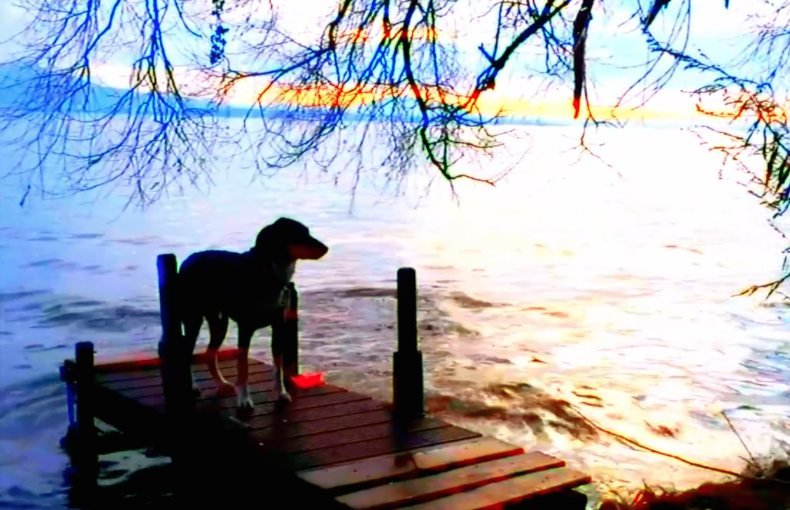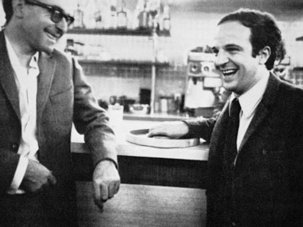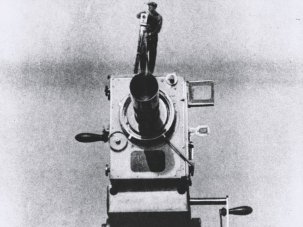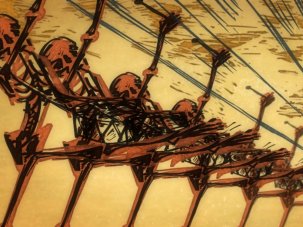Once upon a time, when such things as video stores still existed, there was one of several in New York City which arranged much of its stock, within national sections, according to the sub-category of director. When you browsed through this particular store’s ‘France’, you would pass ‘Dumont’, ‘Duvivier’, ‘Franju’, ‘Gatlif’, and arrive at ‘GODard.’ The G-O-D, you see, was capitalised.
Goodbye to Language is out now on DVD and 3D Blu-ray from Studiocanal. It’s one of our critics’ Best films of 2014.
Unapologetically hyperbolic during his own years as a critic, Jean-Luc Godard doesn’t inspire indifference. If he is a cinematic genius, as he is to a great many, he is the greatest of cinematic geniuses. (David Bordwell, who has written the most in-depth English-language analysis of Goodbye to Language that I know on his blog Observations on Film Art, has coined the term “Godardolater.”) If he is a fraud, as some others contend, than he is the most egregious fraud of all time.
My own feelings on the man who François Truffaut memorably called “the Ursula Andress of militancy” lie somewhere between these poles, though I should think that for a fraud to keep up a scam over such a period of time should constitute a species of genius in itself. When I saw Goodbye to Language (Adieu au langage), Godard’s new 70-minute 3D movie, at the New York Film Festival, the critic Amy Taubin, who introduced the film, identified it as being not only the greatest of the entries in the festival slate, but a work which was every bit as revolutionary as Godard’s Breathless had been 55 years earlier. It would appear atop her 2014 year-end list, as it has on many others to date.
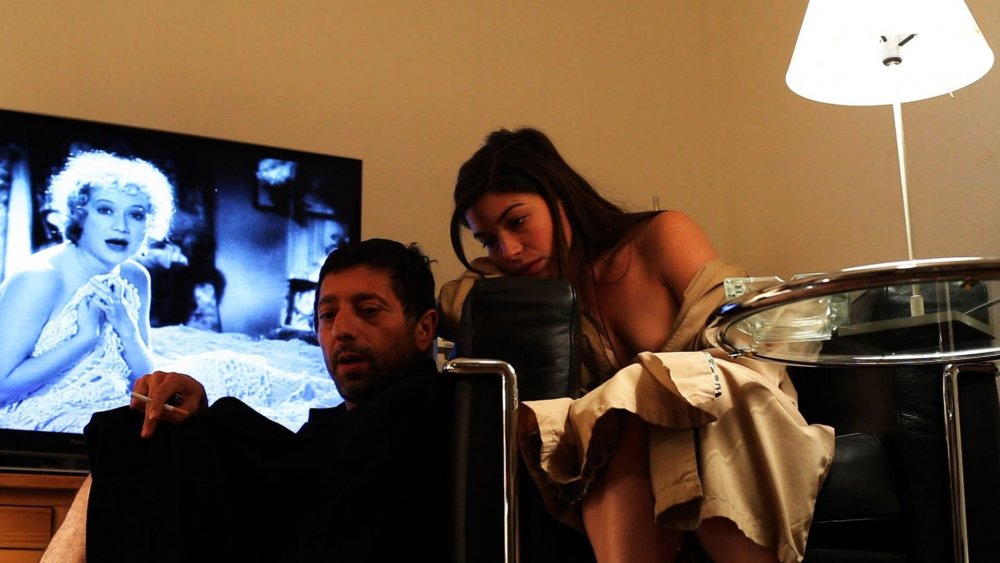
Goodbye to Language contains only a handful of performers, locations and situations, though they are difficult enough to keep track of thanks to Godard’s process of ceaseless obfuscation. Camera position is strategically disadvantageous. Action often takes place in off-screen space, while framing inverts the traditional hierarchies of the essential and trivial. Scenes are separated by uncommented-on ellipses of indeterminate length. Godard’s original material is striated with uncontextualised news footage and clips from other films, a few of the latter also visible on a flatscreen television that’s on in the background during quarrelsome domestic scenes. Dialogue and soundtrack cues are cut just before conclusion or swelling climax, the director always pulling the plug on scenes at the least opportune possible moment, just as they’ve begun to go somewhere.
Goodbye to Language begins with two variations on the same scene, as though challenging the viewer to guess which is the ‘real’ movie. (The answer is: neither.) A ferry on the waters of Lake Geneva, an image to which we will repeatedly return, arrives at a pier. A middle-aged academic, Davidson (Christian Grégori), reads from Solzhenitsyn and Jacques Ellul (the latter on an iPhone) and a book on the painter Nicolas de Staël. A man arrives to confront a young woman, and a lover’s quarrel occurs which has the character of a political assassination – in fact, it may be both at once.
The two openings feature two harassed women played by two brunette actresses of similar appearance, Héloïse Godet (identified as Josette) and Zoé Bruneau (as Ivitch). In the second ‘take’, Ivitch is speaking to a seated Davidson when the man – we may infer from information given later that he is her husband – arrives and angrily confronts her, pushing her backwards before brandishing a gun in her face.
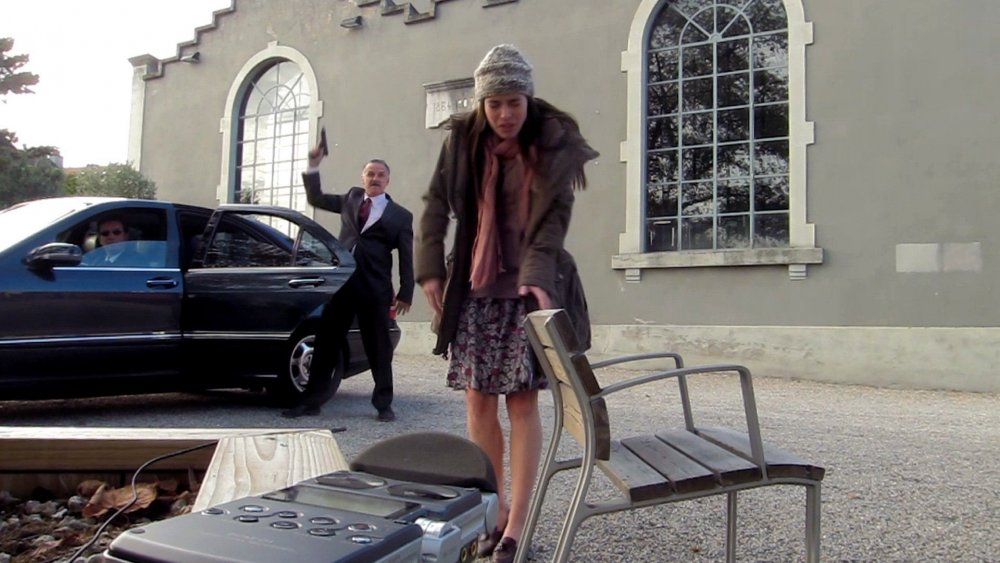
Here Godard employs for not the last time a kind of ‘split-screen’ which is the nearest that his film comes to justifying claims of its revolutionary accomplishment, for it isn’t like anything that I’ve seen before and, on the first viewing, I felt like as though trying to process it might possibly detach my retinas. Goodbye to Language’s stereographic images were achieved through shooting with two parallel cameras, and the effect in question is created by breaking their alignment, as one moves to cover action (Ivitch and her husband) and the other stays put (Davidson on the bench).
The deviating dual cameras are a visual corollary to the doppelgänger structure that Godard keeps up through much of the film, largely made up of two parallel stories introduced by on-screen titles as “1. La Nature” and “2. La Métaphore”, which begins after La Nature has played out in whole. The first section concerns Josette living in sin with a hirsute man named Gédéon (Kamel Abdelli); the second concerns Ivitch living in sin with a hirsute man named Marcus (Richard Chevallier). I employ the adjective because the couples are very frequently seen paddling around their flats as naked as Adam and Eve, and we learn more of these people’s bodies and bowel movements than we get by way of ‘character development’.
Both women were in Kinshasa, the Congo. Josette mentions having been with Gédéon for four years, though only a few minutes earlier she seems to be entering his home for the first time. Abedeli and Chevallier, like Godet and Bruneau, resemble one another so closely as to be nearly interchangeable, as do the film’s ‘halves’: in La Métaphore, scenes from La Nature are reprised, revised, corrected and undermined. Both men, for example, are seen practicing philosophe dans la toilette, their musings accompanied by vivid plops of which the Farrelly Brothers would be proud.

The film’s final major character is ‘Roxy’, played by Roxy Miéville, Godard’s pet dog with his partner Anne-Marie Miéville. Roxy is introduced wandering, seemingly alone, in the forest. A few moments of this seem to cover a matter of years, as the seasons flit from sprint to winter to fall. Roxy is seemingly acquired by Josette and Gédéon during a stop at a gas station – I say “seemingly” because the scene is unclear, the action only ‘seen’ through dialogue (“It’ll do us good.” “Beat it fleabag…”). Roxy belongs wholly to neither ‘half’ of the film, but is something like its roving consciousness.
The film’s two sections are stitched together by various motifs, the most prominent of these being that of water: rain on pavements and slush on windshields, water from showers and fountains, rivers and lakes. The debate is as to whether Goodbye to Language is a shallow, stagnant puddle or contains profound depths, one of the many dichotomies that the film muddles – “What’s difficult is to fit flatness into depth,” as one of its tossed-off pronouncements goes.
I have seen the movie three times altogether now – twice on the big screen, and again on a 2D mp4. This is not because it inspired a wild ardor in me straightaways, but because I wanted to feel I’d dredged it thoroughly. After that NYFF screening, I walked away with a bit of eyestrain and sore from being pelted with aphorisms, unified by their quality of sounding terribly important while failing to hold up under any scrutiny whatsoever, though they follow one after another so quickly that the opportunity to interrogate them never arises. Most of the dialogue fragments are divisible between the trite (“If Russians become Europeans, they’ll never be Russians again”; “Animals are not naked because they are naked”) and the foreboding (“[Images] are the murder of the present”; “Today, everyone is afraid”; “Soon, everyone will need an interpreter to understand the words coming from their own mouths”).
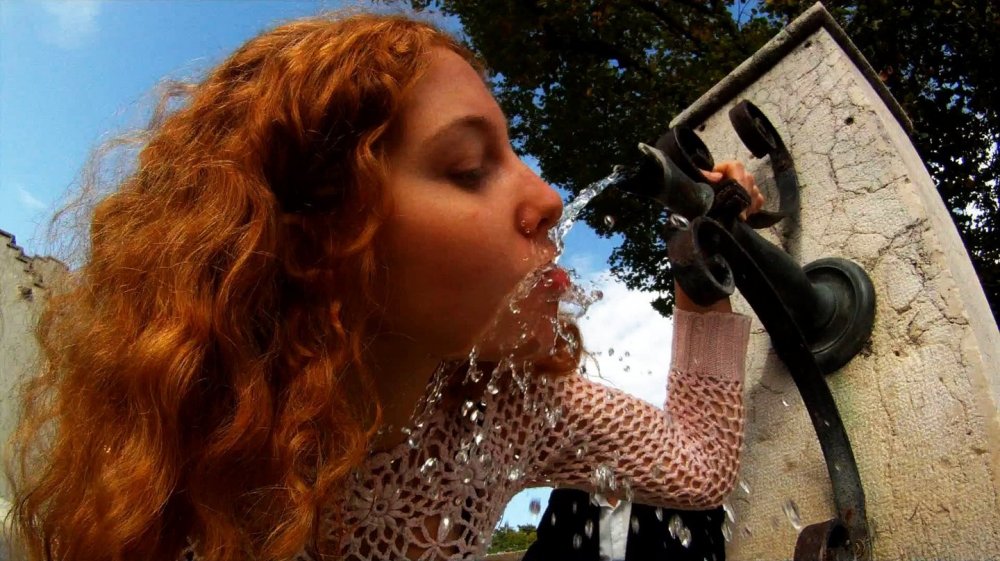
But to give too much weight to words in a film that is, after all, called Goodbye to Language is perhaps not the best tactic to take. The second time I saw the movie in a cinema, the process of trying to follow the film was no longer quite so harrowing, and its sheer loveliness became evident to me in a way it hadn’t been before. It is fairly strewn with flowers, fresh-cut and wilted and growing wild, saturated colour levels rendering them as solid de Staël-esque impastos of red, a red that recurs in Marie Ruchat’s curtain of curly hair and the old “It’s not blood, it’s red” blood. It is a bouquet of textures, attributable to a variety of postproduction filters and technologies – Godard lists his cameras, many of them less-than-state-of-the-art consumer jobs, in the closing credits, right alongside the composers and writers from whose work he has created the decoupage of the film’s sonic element.
Yet still reservations remain. It is no stretch to make a case for the structural audacity and pure plastic beauty of what Godard has made, but I’ve yet to hear a convincing argument for the way in which his political-historical digressions (Che Guevara and Mao Zedong, helicopters and gas chambers) have been integrated to his structural architectonics, or that there is some particular signification in, say, his hard cut between footage of a Nazi motorcade and the Tour de France. At this point in Godard’s work you just wait for World War II to show up in his films like you wait for the cameo in Hitchcock. Which is not a way of churlishly saying “laisser tomber about Hitler already, JLG,” but why go to all the work of radically defamiliarising the everyday if you’re going to banalise historical tragedy at the same time?
So my relationship with Goodbye to Language has not been a honeymoon of unruffled bliss, but I’m glad to have had it, and can say unequivocally that it should be seen in an environment where its 3D effects can do their work – that is to say, in a cinema.
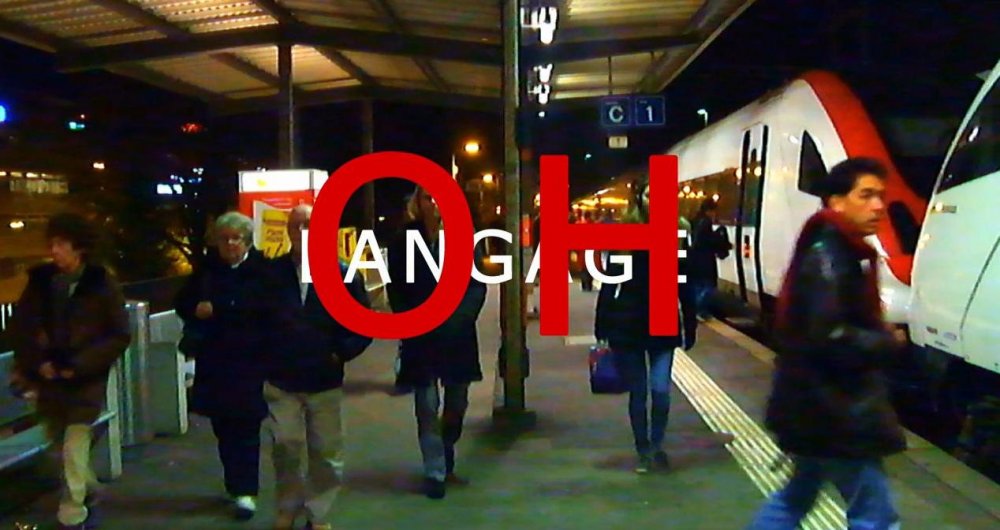
For most UK audiences, however, it’s unlikely that this will be an option. After the film’s screenings at the London Film Festival, distributor Studiocanal has given it a handful of strictly symbolic theatrical dates, the prospect of any more effectively squelched by the fact of the film having been released to DVD last week. If this isn’t an outsized tragedy – good and great films fail to get in front of a potential audience all the time – it is bad business. In the week of its New York opening, Goodbye to Language was tops in per-theatre-average among films opening in under 500 cinema in the US. It is now down to a single screen at the IFC Center where, per one source, it has performed far beyond modest expectations, and it was still pulling a modest crowd when I saw it at 10:30 on a Thursday morning.
Goodbye has it that “Everyone can stop God from existing, but no one does” – but Studiocanal have very nearly stopped GODard.
-
The Digital Edition and Archive quick link
Log in here to your digital edition and archive subscription, take a look at the packages on offer and buy a subscription.




